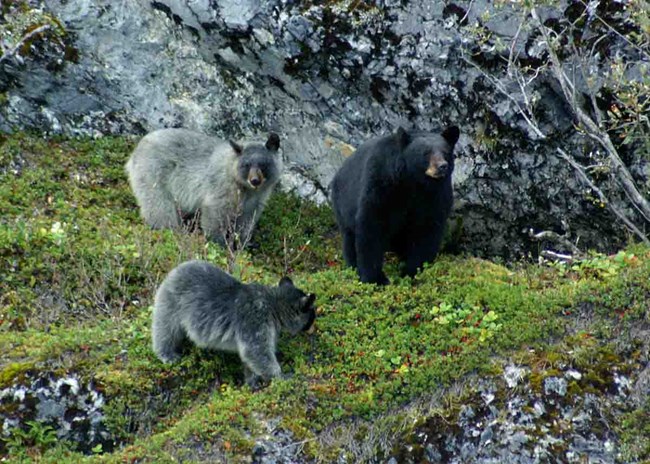Last updated: October 28, 2020
Article
Unraveling the Mystery of the Glacier Bear

C. Edwards
There are few animals as elusive and mysterious as the glacier bear in southeast Alaska and northwestern British Columbia. The region is characterized by deep marine fjords left by the Pleistocene ice advances, steep rugged mountains from ongoing tectonism, and large glaciers and ice fields maintained by persistent cold precipitation. Glacier bears, also known as blue bears, are uncommon color variants of black bears (Ursus americanus) with fur that ranges from white to grey to black with silver-tipped guard hairs. To learn more about these mysterious creatures, National Park Service and Alaska Department of Fish and Game biologists collected genetic material of black bears across the range of the glacier bear color morph. They used noninvasive techniqes to collect hair and tissue samples from harvested bears, noting the color of the bear's coat. Researchers used the DNA to examine genetic structure between populations of black bears within the geographic extent of glacier bears and explored how this structure related to coat color and landscape features of a recently glaciated and highly fragmented landscape. Ten populations of black bears were found in the study area divided largely by geographic features such as glaciers and marine fjords. Glacier bears were assigned to four of the ten populations found on opposite sides of two long fjords (Glacier Bay and Lynn Canal) with a curious absence in the non-glaciated peninsula in between. Lack of genetic relatedness and geographic continuity between black bear populations containing glacier bears suggest a possible unsampled population or an association between glacier bears and large icefields, which would suggest a selective advantage for glacier bears in glacial environments. Such an association would increase the conservation risk of these bears with the unusual coats as glaciers recede suggesting further investigation is needed to determine the adaptive and evolutionary significance of the glacier bear.
Unraveling the mystery of the glacier bear: Genetic population structure of black bears (Ursus americanus) within the range of a rare pelage type
Abstract
Glacier bears are a rare grey color morph of American black bear (Ursus americanus) found only in northern Southeast Alaska and a small portion of western Canada. We examine contemporary genetic population structure of black bears within the geographic extent of glacier bears and explore how this structure relates to pelage color and landscape features of a recently glaciated and highly fragmented landscape. We used existing radiocollar data to quantify black bear home‐range size within the geographic range of glacier bears. The mean home‐range size of female black bears in the study area was 13 km2 (n = 11), whereas the home range of a single male was 86.9 km2. We genotyped 284 bears using 21 microsatellites extracted from noninvasively collected hair as well as tissue samples from harvested bears. We found ten populations of black bears in the study area, including several new populations not previously identified, divided largely by geographic features such as glaciers and marine fjords. Glacier bears were assigned to four populations found on the north and east side of Lynn Canal and the north and west side of Glacier Bay with a curious absence in the nonglaciated peninsula between. Lack of genetic relatedness and geographic continuity between black bear populations containing glacier bears suggest a possible unsampled population or an association with ice fields. Further investigation is needed to determine the genetic basis and the adaptive and evolutionary significance of the glacier bear color morph to help focus black bear conservation management to maximize and preserve genetic diversity.
Lewis, T. M., G. Roffler, A. Crupi, R. Maraj, and N. Barton. 2020. Unraveling the mystery of the glacier bear: genetic population structure of black bears (Ursus americanus) within the range of a rare pelage type. Ecology and Evolution 10(14): 7654-7668.
